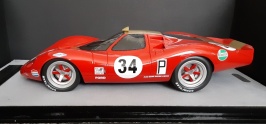The Ford P68, also commonly known as the Ford 3L GT or F3L, is a sports prototype racing car model introduced in March 1968.
When Ford withdrew from sports car racing because of rule changes after the 1967 season, private teams were left to defend the Blue Oval's honours. Two of the best known of these privateers were John Wyer Automotive and Alan Mann Racing, who both took different paths to achieve the same objectives. Wyer continued development work on the 5 litre GT40 and was rewarded with two Le Mans victories, whereas Mann decided to construct a completely new car to suit the new 3-litre regulations and was rewarded with, well, nothing.
While Ford and Shelby were busy constructing their second Le Mans winner; the Mk IV GT40, Ford of Europe backed specialists Cosworth were in the process of constructing the single most successful F1 engine ever. The dramatic rule changes at the end of the 1967 seasons saw displacement limits for prototypes set to just 3 litres and a new GT class introduced for cars with a production of 50 or over. The GT40 was eligible for the GT class and the new F1 engine would be perfect to power a 3-litre prototype.
With some backing from Ford Europe and sponsors Castrol and Goodyear, Alan Mann Racing set out to design a 3 litre prototype around the Ford Cosworth DFV engine, which was officially dubbed 'P68', but is more commonly known as the 'F3L' (Ford 3 Litre). Renowned aerodynamics expert Len Bailey was responsible for the car's characteristic shape. A small window was made in the roof, helping it to pass as for a open-top car, which allowed for a much lower roofline.
With a drag co-efficient of just 0.27 the F3L was capable of top speeds of well over 350km/h. Although the Len Bailey designed body allowed for incredible top speeds, the F3L was also feared for high speed instability, so much so that John Surtees refused to drive one. Later research in wind tunnels showed that the body did in fact create downforce, but mostly on the front wheels, which caused the much feared instability at high speed. Over its career the nose received a small lip and a rear wing was tried to create more downforce.
The ultra-thin gauge body clothed an aluminium monocoque. As on the Lotus 49, the first Formula 1 car to use the Ford Cosworth DFV, the V8 was bolted directly to the aluminium and served as a fully-stressed member of the chassis. The fully independent suspension was also inspired by contemporary F1 designs. In an extremely short period of time Alan Mann Racing constructed the world's first 2-Seater Formula 1 car. In a striking red/gold livery, the F3L made its racing debut just four months into 1968, which was less than a year after the DFV was first raced.
At the F3L's debut in the 1968 BOAC 500 at Brands Hatch, the two cars entered were far from ready to race. The first car had been tested briefly, but the second car was brand new and untried. In the first practice the car that had been tested dropped its engine and was out for the weekend. With Bruce McLaren at the wheel, the other car recorded the second fastest time. In the race McLaren took the lead, but 50 minutes into the race a driveshaft coupling failed, ending the race for the F3L. It nevertheless was a promising debut for the car that was obviously very fast, but needed more work to sort out the reliability issues.
One of the two cars was destroyed after hitting a hare in the practice for the next race, the 1000 km on the Nürburgring. The second car did not fair much better and after a series of problems, the engine stopped on lap three of the race. Highlight of the F3L's racing career was Frank Gardner's pole position at the Spa 1000 km a week later. He beat John Wyer Racing's, Jacky Ickx piloted GT40 by over 4 seconds. Again reliability problems let the car down in the race, this time after just one lap.
The F3L took part in two more races in 1968, but again its good pace was ruined by reliability issues. For 1969 an open top version was constructed, dubbed P69, which shared P68's cruel faith and never made it to the starting grid of a single race. The coupe covered just 14 laps of racing in 1969; it's engine failed after 14 laps at the BOAC 500 and it was pulled of the grid of the Silverstone Martini Trophy with a misfiring engine. This was a sadly a fitting end to the short-lived career of the red and gold racer.
Money problems and Ford's reluctance to put a real effort into the F3L make the strikingly beautiful racer one of motorsport's biggest could-have-beens. When it worked properly, the F3L was blisteringly quick, unfortunately it will be remembered as the racer that failed to finish a single race. The DFV engine did eventually become successful as a sports car engine, winning at Le Mans in 1975 but ironically in the back of the John Wyer Automotive developed Mirage.
Specs:
_____________________________________________________________________________









